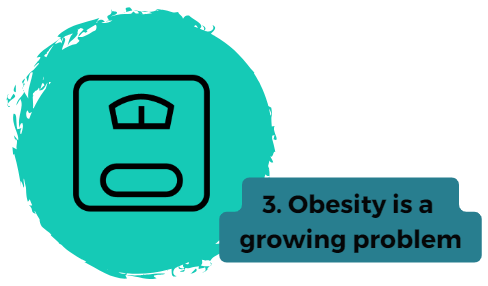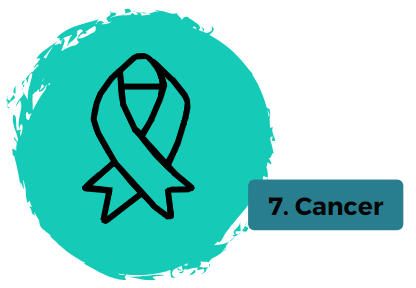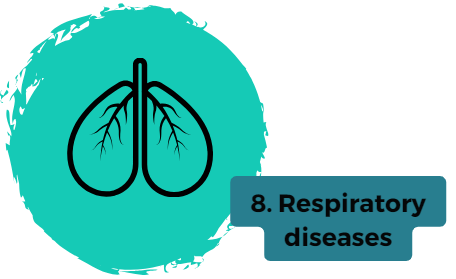Below are 10 key health challenges for Wakefield district in 2023. For more detailed factsheets, see the JSNA Annual Reports.

Current data suggests a child born in Wakefield District can expect to live on average 77.0 years (males) or 80.9 years (females). Population estimates predict that in the next 10 years the population aged over 75 will increase by 28%, from 30,000 to just over 40,000. The growth in life expectancy has stalled in recent years and the number of years a person can expect to live a healthy life, free from illness or disability has been falling. Healthy life expectancy for males is currently 58 years and for females it is 56.7 years. This means that both men and women are living for longer in poor health – around 19 years for men and 25 years for women.

There is a strong link between health and wealth, with many people in the poorer parts of the district experiencing worse health outcomes. People from deprived backgrounds are far more likely to be a smoker, have excess weight, have a long term condition, and subsequently die younger. Men in the most deprived areas of Wakefield District can expect to live around 9 years fewer than those in the most affluent areas. For women this is 8 years.

The proportion of the adult population who living with overweight (72%) or obesity (35%) is increasing. Excess weight is also increasing in children, with around 23% of reception children and 39% of Year 6 children living with excess weight in 2022/23. Obesity in pregnancy is also an issue, with only 4 in 10 pregnant women having a healthy weight. Along with smoking, excess weight has the greatest impact on population health.

Smoking prevalence in adults has fallen from 1 in 4 in 2012 to 1 in 8 in 2022, however prevalence is much higher in deprived areas and those from routine and manual occupations. Despite positive decreases in recent years, smoking remains one of the largest causes of preventable ill health in Wakefield. Smoking in pregnancy has also dropped, but remains significantly higher than the national average. The proportion of young people trying smoking is reducing, however there has been a stark increase in those trying vaping, with 1 in 3 Year 9 pupils saying that they have used a vape.

Mental ill health makes up a large part of morbidity in Wakefield, and accounts for the majority of sickness absence along with musculoskeletal health (neck and back pain). Our school health survey is telling us that the mental health of our children is getting worse, with only 50% of Year 9 reporting feeling happy with life. Over 50% of both Year 7 and Year 9 report feeling lonely some or most of the time. Wakefield has the second highest rate of hospital admissions for self-harm in the region, significantly higher than the England average. Suicide rates remain high with men more likely to take their own life than women. Wakefield’s suicide rate is the 2nd highest in the Yorkshire and Humber region.

High prevalence of risk factors such as smoking, obesity and alcohol consumption means that Wakefield is worse than the national average in many CVD outcomes. GP recorded Hypertension prevalence = 16.1%, compared to 14.4% nationally. Estimates suggest true prevalence could be much higher. Males experience poorer CVD outcomes than females, with the rate dying prematurely from cardiovascular disease twice as high for males.

Cervical and bowel cancer screening coverage in Wakefield remain above the national average, while breast cancer screening coverage is below. Breast and cervical screening programmes have both seen a drop in coverage since the pandemic and some cancer outcomes are poor compared to the national position. The proportion of cancers diagnosed at stage 1 or 2 is 52.5%, which is similar to the England proportion of 54.4% (2021). Under 75 mortality from cancers considered preventable is significantly worse in Wakefield: 66.2 per 100,000 compared to 50.5 nationally (2020-22).

The prevalence of respiratory conditions in Wakefield remains significantly higher than the national position. COPD prevalence in Wakefield is 2.7% vs 1.8% in England (2022/23). Males have poorer respiratory outcomes, including a higher COPD mortality rate. The under 75 mortality for respiratory conditions is 40.4 per 100,000, much higher than nationally – 30.7 (2022).

It’s not straight forward to try and plan and predict for future years, in 2018 did anyone predict: The Coronavirus pandemic, the war in the Ukraine, the cost-of-living crisis, inflation at 8%+ or heat related records being broken across the planet at an alarming rate? The interaction of broad societal pressures and changes, climate change impacts, and issues like poverty and inequality interact in complex and unpredictable ways to create illnesses and health and care pressures. An ability to respond and flex to long-term changes and short-term fluctuations and / or emerging situations will remain important.

Pandemics remain a risk, as does the growth in antimicrobial resistance. We must maintain high quality infection prevention and control measures against a backdrop of increased demand and workforce pressures. There are potential increases in vaccine preventable illnesses which are driven by falls in immunisation rates, creating a burden of illness in the population and business continuity and service demand issues. More severe and frequent adverse weather like heatwaves, cold snaps and pollution events can influence air quality, changes in disease vectors and related risks can cause food safety issues, and growth in international migration could see changing patterns of diseases.
